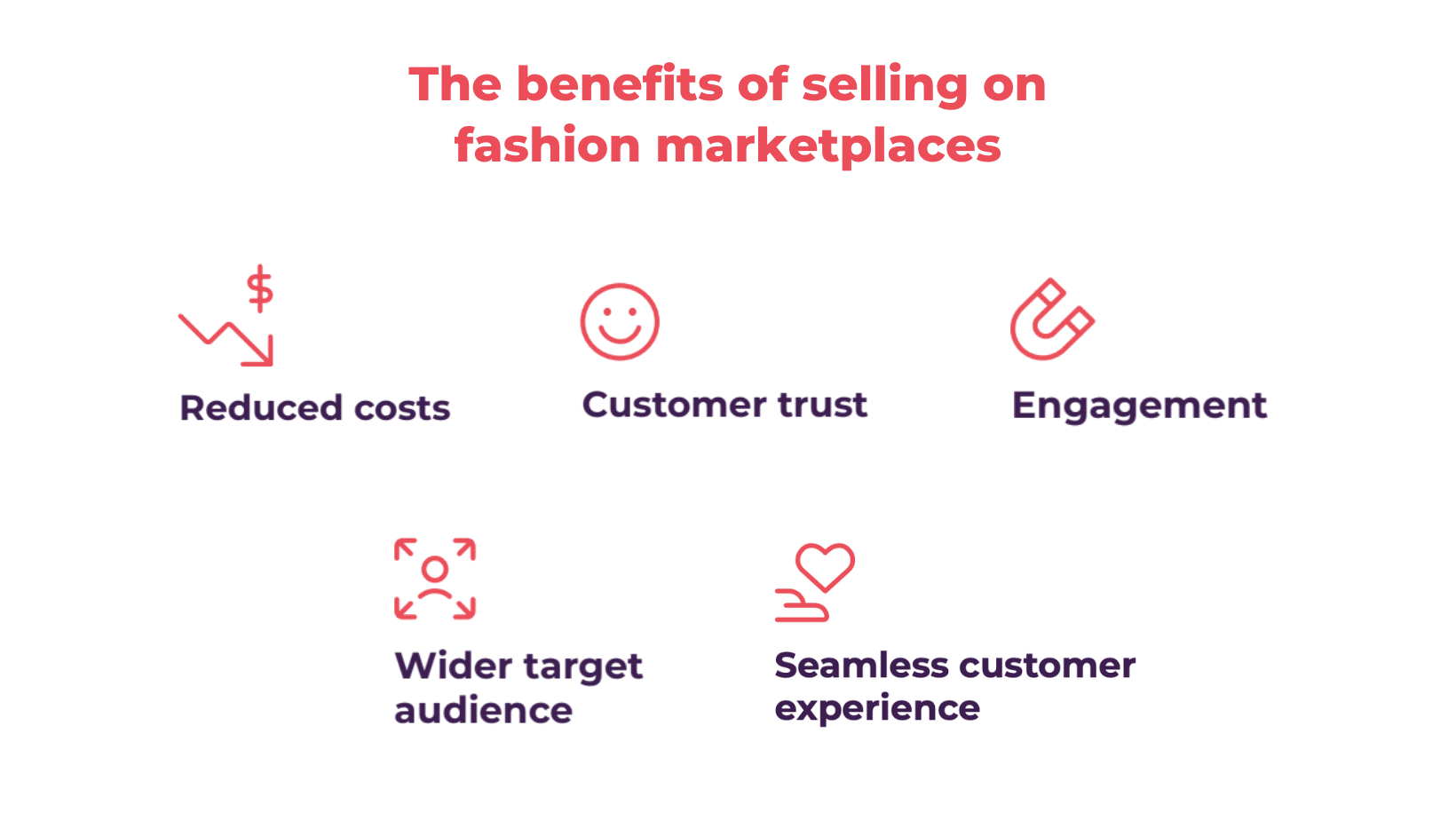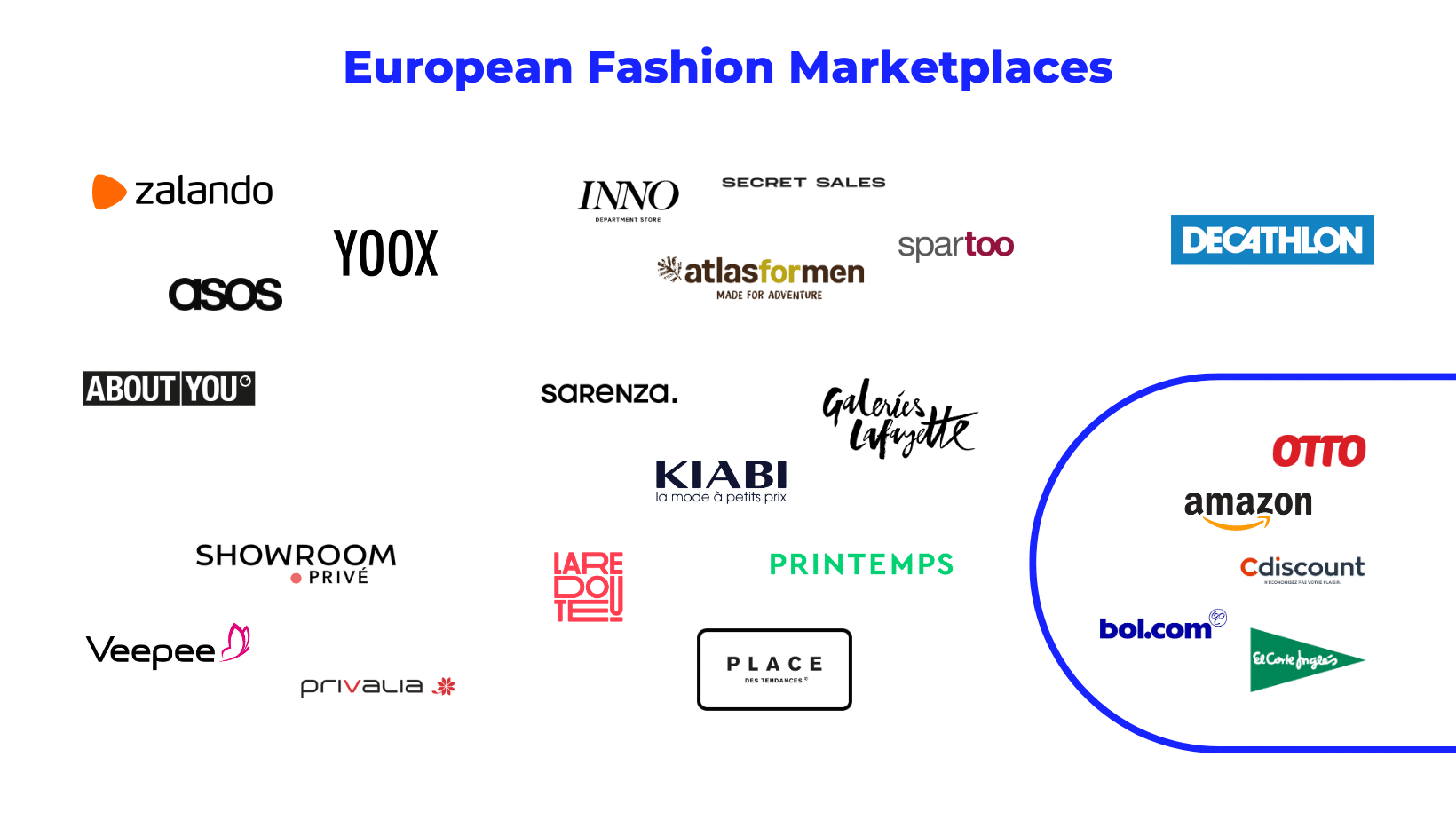What are the main fashion marketplaces in Europe?
09/04/24
7'
Fashion marketplaces present a low-risk avenue for sellers to showcase their collections, catering to fashion enthusiasts who seek the convenience of exploring a broad selection of products around the clock. As the allure of this business model becomes increasingly evident, numerous fashion marketplaces are emerging, aiming to carve out their niche. Yet, despite this proliferation, the major global platforms maintain their stronghold in the industry. Here’s an overview.
The benefits of selling on marketplaces
Fashion marketplaces give sellers the opportunity to offer their range at a much lower risk than through a dedicated retail store. Fashion shoppers want to browse a wide choice of products at any time of day or night and marketplaces facilitate this immensely. Further advantages below:

Benefits to sellers:
- Reduced costs: Limited set-up and marketing costs, as there’s no need to set up an online or physical store. If a seller already has a store this is an additional channel to give their brand more exposure.
- Wider target audience: Selling through a marketplace, especially a well-known one such as Zalando or YOOX, opens up the possibility of global sales. How else can a fashion retailer easily reach such a wide market? However, they must consider shipping costs abroad to be sure there is a financial benefit.
- Customer trust: Selling a brand on a platform such as Zalando projects a professional image that implies the business is reputable. This can build customer loyalty. The customer assumes they will receive good customer service in the event of any problems, and the marketplace takes this responsibility.
- Engagement: Buying from an established fashion marketplace with a sound reputation also brings engagement. Marketplaces are growing and expanding their presence, for example, Zalando’s recent acquisition of a stake in Highsnobiety. Marketplaces spend a large portion of their budget creating inspirational images and lifestyle scenarios to encourage purchases.
- Seamless customer experience: Marketplaces offer automated ordering and a seamless customer experience whenever and wherever they are. There are no issues with time zones, giving wider possibilities for trading. Customer services teams operate 24/7 on the larger marketplaces, so queries can be answered immediately.
The top European fashion marketplaces

Zalando
As the largest fashion marketplace in Europe, this German company is a major player in online fashion. They reported an increase in the number of customers over the 12 months to the end of March 2022 as 17%, reaching 49 million with an annual revenue of 10,14 billion euros in 2023. To enhance customer engagement Zalando states it is extending Zalando Plus membership (premium delivery, early access to new stock releases, personal stylist advice). Membership of this service (similar to Amazon Prime) increased 150% year on year, making it another way to benefit from selling on a marketplace.
ASOS
With a strong social media presence and its target market being Generation Z, ASOS aims to be “the world’s number-one destination for fashion-loving 20-somethings”. The company achieved a 20% increase in revenue between 2020 (3,26 billion GBP) and 2022 (3,93 billion GBP). It is very strong in the UK and becomes more popular in continental Europe.
Did you know that ASOS is the short for “As Seen On Screen”?
YOOX
This relatively new marketplace targets the higher spend customer in Europe, with plans to expand globally. The company sells the lifestyle idea, rather than just individual items. Primarily selling in Italy, with many Italian brands, YOOX has expanded to the rest of Europe and has seen year-on-year growth since the pandemic, with net sales of USD 897.9M in 2021.
La Redoute
The French marketplace best known for fashion and homeware. With over 650 sellers and brands such as Adidas and Mango, La Redoute is a popular choice for fashion purchases in Europe. In 2022, La Redoute reported an annual revenue of over one billion euros. In March 2022, Galeries Lafayette declared its acquisition of La Redoute.
ABOUT YOU
One of Europe’s fastest growing fashion marketplaces, as of 2023 operational in 26 countries in Europe. In 2021, the platform already counted 27 million unique active users per month.
Secret Sales
The first online flash marketplace to launch in the UK, the core business is designer label fashion with the enhancement of cosmetics and homeware. This marketplace also offers pre-owned designer fashion and accessories.
Veepee
A relatively new player in the fashion marketplace arena, Veepee was launched in 2018 and now has 66 million members. Focussing on fashion and homewear, Veepee is a French-based marketplace and also supports lesser-known brands. It has more than 200.000 unique visitors per day and 2/3 of them are women.
Showroomprive
A French marketplace with a revenue of €1 billion in 2021 that offers daily fashion flash sales that last up to a week. The company has expanded throughout Europe and sells premium fashion at discounted prices.
Atlas for Men
A marketplace specialising in outdoor clothing and casual clothes for men. Based in Paris, the marketplace achieved over €276 million in 2021, and is present in 14 countries.
Spartoo
Launched in 2006, Spartoo offers over 300,000 pairs of shoes from 3,800 top brands, catering to a variety of styles including trendy, comfortable, and easy-to-wear. It also includes a wide collection of women’s clothing and is available in several European countries. Customers can find exclusive models and enjoy significant savings during sales, promotions, and private sales, all with the lowest price guarantee.
Printemps
Since its inception in 1865, Printemps has epitomized French elegance across fashion, luxury, beauty, and lifestyle, with 20 stores in France and over 3,000 selected brands. Its digital platform, Printemps.com, features more than 500 brands, focusing on luxury and designer items. With 70% of its online customers being French, Printemps.com emphasizes its local appeal and distinguishes itself by selling brands directly, ensuring authenticity and quality in luxury offerings.
Galeries Lafayette
Galeries Lafayette, founded in 1894, stands as France’s premier department store and a significant online marketplace. Contributing over 18% to GL.com’s sales, it boasts 330,000 active customers, with a predominantly female base (74%) aged between 25 and 45, reflecting its appeal to young and mid-career shoppers. The average purchase is €105, including VAT.
Sarenza
Sarenza, a leading luxury and fashion e-commerce platform, operates a marketplace with sales reaching 195 million euros in 2019, from 25 million products sold across 29 European countries. It boasts an 8 million strong European customer base, attracting over 100 million annual visits. Predominantly female (78%), its customers average 38 years old, with a high shopping frequency—80 euros per basket and 15 purchases annually.
Privalia
A marketplace based in Barcelona, Spain, with a global sales figure of USD 939.4m in 2021. The advantage of Privalia is its strong presence in Spanish-speaking markets like Spain and Mexico, but also in Italy and Brazil.
INNO
A new marketplace launched in 2021 and based in Belguim. INNO, the Belgian department store chain, only currently sells to the Belgian and Dutch markets.
Kiabi
Since its inception in 1978, Kiabi has established itself as the preferred brand for French consumers in the Child and Baby category, boasting an impressive marketplace that attracts 13 million monthly visits. The brand offers a diverse range of products such as childcare essentials, toys, ready-to-wear clothing, lingerie, shoes, accessories, and items for children’s and baby’s rooms. With a global footprint spanning 25 countries and 550 stores, Kiabi has also successfully embraced the digital age, with 18% of its business activities conducted through online platforms.
Decathlon
The world leader in the sports market is also selling sports and fitness clothing. Decathlon is present, among others, in France, Germany, the UK, Spain, Italy and Belgium. The Belgian Decathlon marketplace alone registers more than 13 million unique views each month. Decathlon’s digital turnover is 2,5 billion euros and it’s total omnichannel turnover 11 billion euros.
General marketplaces known for goods such as homeware, electronics, toys and books are also important fashion marketplaces, albeit on a smaller scale to the specialists. These include Amazon, OTTO, bol.com, El Corte Inglés, and Cdiscount. Worth noting is that clothing, shoes and jewellery rank as the 4th highest sales category on Amazon, giving it a competitive edge against marketplaces dedicated entirely to fashion.
The influence of social shopping on marketplaces
Social media is a big part of online fashion marketing. Brands give influencers free garments to post themselves wearing them on platforms such as Instagram or TikTok. This relatively new way of marketing focuses on customers making buying decisions based on reviews.
An example of the influence of social media on marketplaces can be seen from the popularity of a specific brand of leggings, promoted by TikTok users. This had no input from Amazon and came from one TikTok user posting a video of the leggings. The post received over 2.5 million views, with ‘TikTok’ leggings becoming one of the most searched phrases on Amazon over a 30-day period. This demonstrates the power of this form of marketing.
Your e-commerce library
Sign up for our newsletter
By submitting this form you authorize Lengow to process your data for the purpose of sending you Lengow newsletters . You have the right to access, rectify and delete this data, to oppose its processing, to limit its use, to render it portable and to define the guidelines relating to its fate in the event of death. You can exercise these rights at any time by writing to dpo@lengow.com

Trending Posts
Marketing channels
ChatGPT Ads and advertising on GenAI Search Engines: what you need to know
Advertising on generative AI-based search engines (GenAI) marks a new era in digital marketing. After two decades dominated by traditional…
22/05/25
6'
Marketing channels
Reddit and Social Commerce: When Users Take Back Control
Before buying anything, we compare. We hesitate. And more and more often, we end up typing the product name followed…
30/06/25
8'
Marketing channels
How to Sell on TikTok in 2025: The Ultimate Guide to Success
To sell or not to sell on TikTok? That remains a question many brands ask themselves. But here’s what you…
03/02/25
7'
E-commerce Trends
E-Commerce 2025: The New Rules of Digital Retail
What’s going on in e-commerce? A lot. If 2024 was the year brands got comfortable with marketplaces, AI tools, and…
11/07/25
8'
Marketing channels
Omnichannel Strategy: The Best Examples of Successful Brands
Consumers interact with brands through multiple channels, including online, in-store, and mobile apps. More than 90% of consumers expect a…
04/04/25
5'




